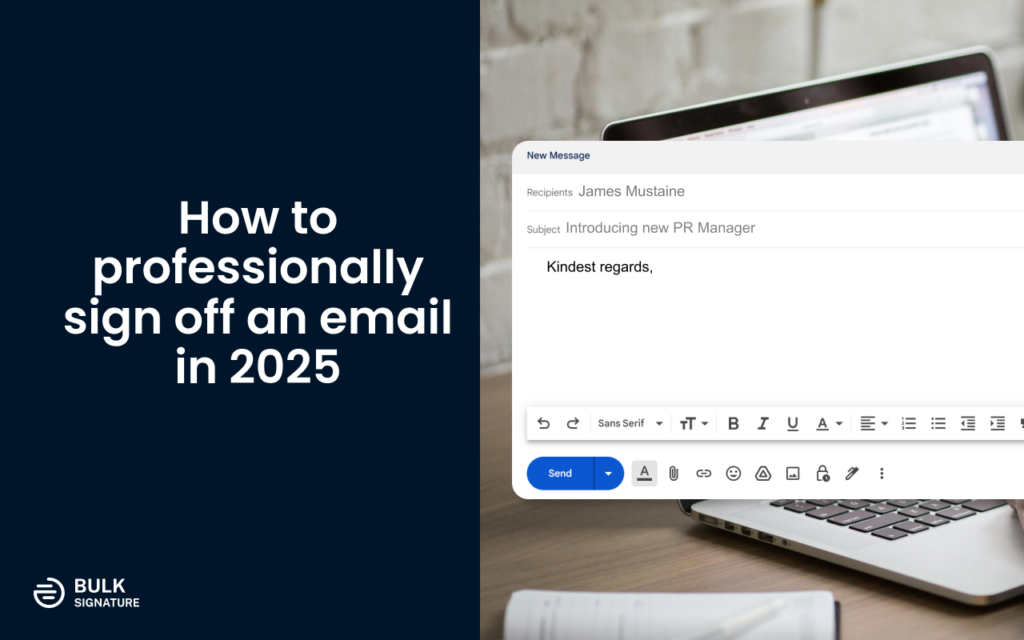
Crafting a well-written email goes beyond just the body content. Knowing how to sign off an email is equally important, leaving a lasting impression on the recipient. A strong sign-off can build rapport, encourage a response, and solidify your professionalism.
In this guide, you will learn what sign-off options for different email contexts you can use in your email communication. The goal of the article lies in helping you choose the perfect closing for every situation.
What is a Sign-Off in an Email?
An email sign-off, also known as a closing or email signature line, is the concluding part of your email that comes after the body content. It typically consists of a courteous phrase followed by your name and contact information (often included in a separate email signature block).
Here are what primary purposes sign-off may serve:
Conveying professionalism: A professional sign-off demonstrates respect and courtesy to the recipient.
Setting the tone: The chosen phrase can establish the formality or informality of the email.
Encouraging a response: Certain sign-offs can subtly nudge the recipient to take action, such as replying or scheduling a meeting.
The Importance of Email Sign-Offs
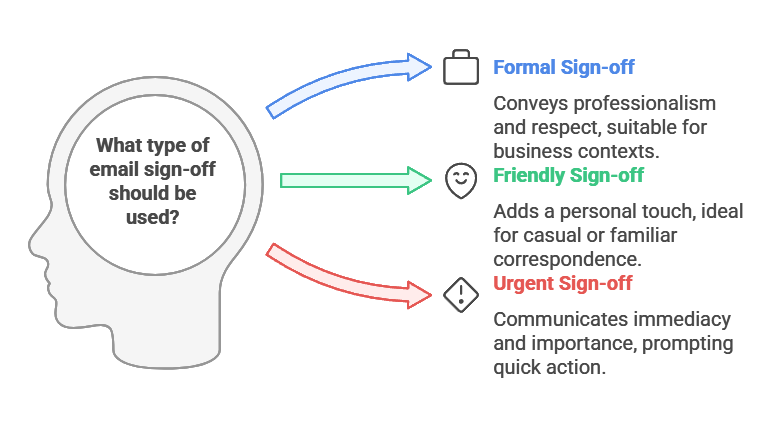
A well-chosen email sign-off is a crucial element of professional communication. It reflects your professionalism and leaves a lasting positive impression on the recipient. Just as the opening of an email sets the tone, the closing reinforces it, ensuring that your message is complete and polished. A thoughtful sign-off can also reinforce the tone of your email, whether it’s formal, friendly, or urgent, helping to convey the right message to your recipient.
Moreover, consistent and appropriate sign-offs can play a significant role in building and maintaining professional relationships. They show that you pay attention to detail and care about how you present yourself in written communication. Over time, a well-crafted sign-off can become part of your personal brand, making your emails more recognizable and memorable.
How to Sign Off an Email Professionally
For professional emails, a formal or neutral sign-off is generally preferred. While the content of your message is crucial, the way you close your email can leave a significant lasting impression. A professional sign-off demonstrates several key qualities that can benefit you and your career. Here are some key considerations for how to sign off an email professionally:
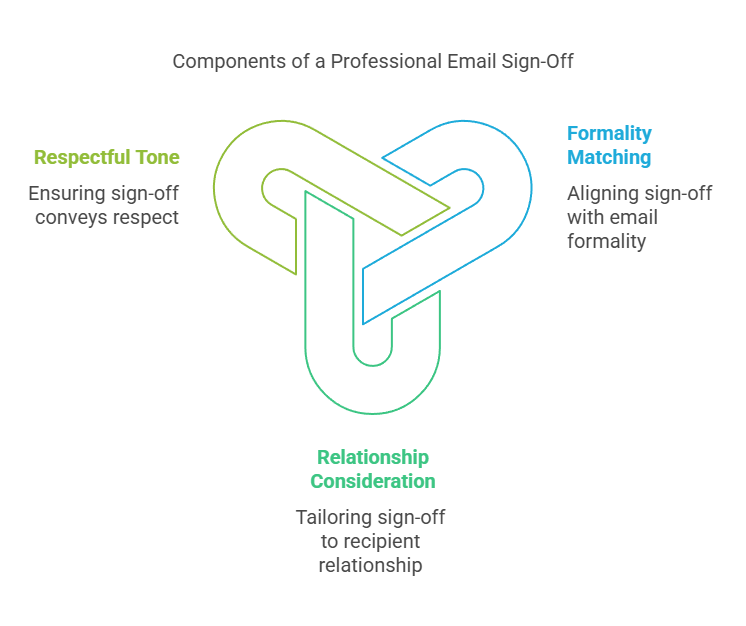
Match the formality of the email: A formal email to a new client or boss may require a more traditional sign-off, while a follow-up email to a colleague might allow for a slightly less formal tone.
Consider your relationship with the recipient: If you have a well-established professional relationship, you might opt for a slightly less formal closing.
Maintain a respectful tone: Regardless of the specific phrase, ensure your sign-off conveys respect and professionalism.
A professional email closing can help you achieve various communication goals including. Here are the key communication goals your sign-offs can allow you achieve:
Establishes Credibility and Respect: A well-chosen closing conveys professionalism and courtesy to the recipient. This is especially important for initial communication or emails to superiors or clients.
Sets the Tone: The formality or informality of your sign-off can subtly establish the tone of the email. A professional sign-off reinforces the seriousness and importance of the message.
Encourages a Positive Response: Certain professional sign-offs can subtly nudge the recipient to take action. For example, closing with “Thank you for your time” might encourage a reply, while “Looking forward to hearing from you” prompts a response.
Projects a Polished Image: A professional sign-off contributes to a polished and well-crafted email, reflecting positively on your personal brand and the company you represent.
Types of Email Sign-Offs
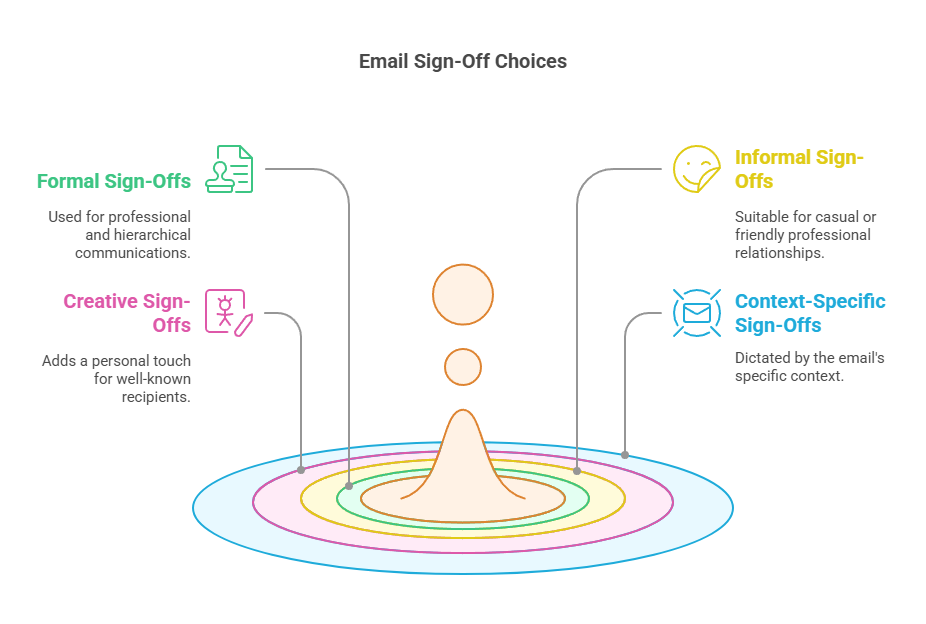
Choosing the right email sign-off depends on the context of your message and your relationship with the recipient. Here are some common types of sign-offs and when to use them:
1. Formal Sign-Offs Formal sign-offs are suitable for professional and business communications, especially when writing to someone you don’t know well or in a hierarchical relationship.
2. Informal Sign-Offs Informal sign-offs are more relaxed and can be used in casual or friendly professional relationships.
3. Creative Sign-Offs Creative sign-offs can add a personal touch and make your emails stand out. They are best used when you have a good rapport with the recipient.
4. Context-Specific Sign-Offs Sometimes, the context of your email dictates a specific type of sign-off.
Choosing the right sign-off can enhance your email’s effectiveness and leave a positive impression. Always consider the nature of your relationship with the recipient and the context of your message when selecting a sign-off.
15 Ways to Sign Off an Email Formally
While a friendly tone can be appropriate in some email exchanges, there are situations where a formal sign-off is the preferred choice. The key scenarios where a formal closing is recommended include initial contact, communication with the managing levels, formal inquiries, communication with stakeholders, or in email to professors, teachers, or instructors. By understanding these situations, you can confidently choose a formal sign-off whenever necessary. Here is how you can sign off your formal emails:
Sincerely, (Classic and widely appropriate)
Best regards, (Safe choice for most business emails)
Respectfully, (For situations requiring extra deference)
Thank you, (Expresses gratitude while remaining professional)
All the best, (Neutral and positive closing)
Kindest regards, (Courteous and professional)
Yours sincerely, (Formal option for new contacts)
Very respectfully, (In some cases can be seen in the abbreviated form as V/R, which is used primary in military, but it is getting popular in business communication as well)
Best wishes, (Suitable for closing business introductions)
Regards, (Simple and professional)
I appreciate you taking the time (Professional and motivating)
Keep up the great work (Motivating, used in communication between a manager and an employee)
I look forward to hearing what you think (Highlights that you are expecting a reply)
Thank you for this opportunity (Good for employees or job-seekers)
Warmly (Positive closing, rarely used)
15 Ways to Sign Off an Email Informally
While professional sign-offs hold their place, informal closings can be a great way to build rapport and create a more approachable tone in your email communication. For casual communication or emails to colleagues you know well, a more informal sign-off might be appropriate. Other situations when informal email closing can be of good use include internal team communication, follow-ups on previous emails with somebody who you’ve already been in contact with, Here is how you can sign off your emails informally:
A nice day to you and your team! (Informal for external communication)
Best, (Straightforward and friendly)
Talk soon, (Encourages further communication)
Thanks, (Simple and expresses appreciation)
Cheers, (Upbeat and casual)
Have a great day, (Positive and well-wishing)
Take care, (Expresses concern and warmth)
See you later, (Informal closing for colleagues)
Onwards and upwards! (Motivational and informal)
Best of luck, (Supportive and informal)
Thanks in advance, (Informal way to express gratitude for future actions)
Enjoy your day (Positive and well-wishing).
Thank for your time! (Positive, simple, well-wishing)
See you around (Good for internal communication between peers)
Hope you have an enjoyable day! (Positive and well-wishing)
10 Casual Sign-Offs to Use in Your Emails
If you think your communication with some of your recipients goes beyond the semiformal level, and you prefer a more casual way to close your email, then you should consider some examples below. Casual sign-offs can add a touch of personality and warmth to your email communication. Here is how you can casually sign off your emails:
Catch you later, (Informal and friendly)
Signing off, (Simple and straightforward)
Keep it coming! (Energetic and informal)
Cheers to the weekend! (Positive and situational)
Hit me up if you need anything! (Friendly and offers further communication)
Be right back! (Playful and informal)
Happy trails! (Positive and lighthearted closing)
Peace out! (Informal and lighthearted)
Happy [day of the week]! (Common even in formal communication)
Enjoy the day, (Positive, lighthearted)
Bonus: You can also add emojis to your casual sign-offs to further personalize your message. However, be mindful of the recipient and context, as emojis can sometimes be perceived as unprofessional.
10 Creative Sign-Offs to Use in Your Emails
It’s always hard to find a cool sign-off phrase for your emails. However, for a touch of personality, you can consider some creative sign-offs (use with caution depending on the recipient and context). Here is how to sign off your emails creatively:
Keep on rocking! (Energetic and informal)
Wishing you a productive week! (Positive and well-wishing)
Stay true to yourself (Positive, energetic)
On a mission to... (Intriguing and leaves a lasting impression)
Have a great procrastination! (Funny, use with caution)
Stay awesome! (Well-wishing, positive, good for close contacts)
Follow your heart! (Positive, energetic)
Stay locked in! (Stay focused or committed to something, originated from memes)
Keep up the grind! (Motivating, positive)
10 Thank-you Sign-Offs to Use in Your Emails
Appreciation in email communication is one of the most common points. For that reason, highlighting your appreciation can be a powerful closing technique. Here are some examples that you can sign off an email with. Here is how to thank someone using a sign-off in your emails:
Appreciate your assistance, (Formal, balanced)
Thanks for your hard work on this, (Semiformal, primarily used by managers to employees)
I couldn’t have done it without you, (Informal, used between colleagues/peers)
I owe you one, (Informal, used between colleagues/peers)
My deepest gratitude, (Very formal, situational, can be considered far-fetched)
Thanks for having my back, (Informal, used between colleagues)
Can’t thank you enough, (Informal, used between colleagues)
Much appreciated, (Formal, commonly used)
Beyond grateful, (Very formal)
I stand in recognition, (Very formal, can be considered far-fetched)
The Value of Email Signature after a Sign-off

While a well-chosen sign-off is essential, a professional email signature can elevate your email communication even further. Imagine the impact if every email you send leaves a lasting impression that reinforces your brand awareness and potentially generates new leads.
BulkSignature, for example, is an email signature management solution designed specifically for Google Workspace environments. With BulkSignature, you can create and manage consistent, professional email signatures for your entire team, ensuring brand consistency across all communications.
Here are some key benefits of utilizing an email signature solution like BulkSignature:
By combining a well-crafted sign-off with a professional email signature, you can ensure your emails leave a positive and lasting impression, fostering stronger relationships and potentially driving business growth.
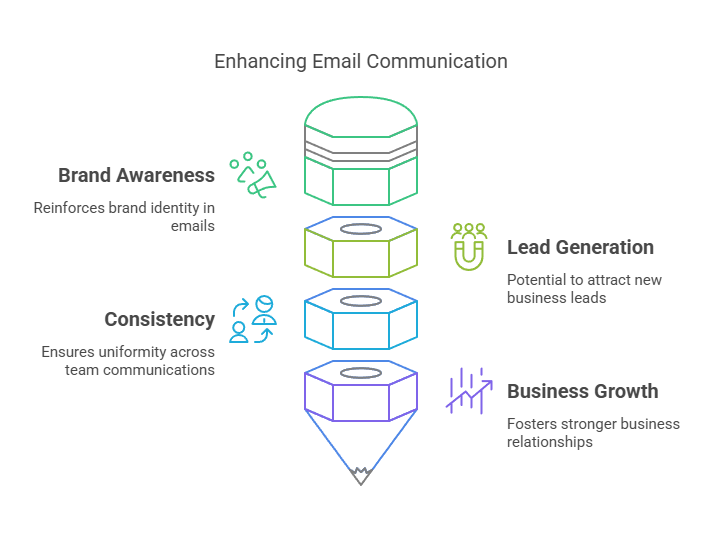
Here are the key benefits of using email signature management solutions like BulkSignature:
While a well-chosen sign-off is essential, a professional email signature can elevate your email communication even further. Imagine the impact if every email you send leaves a lasting impression that reinforces your brand awareness and potentially generates new leads.
BulkSignature, for example, is an email signature management solution designed specifically for Google Workspace environments. With BulkSignature, you can create and manage consistent, professional email signatures for your entire team, ensuring brand consistency across all communications.
Here are some key benefits of utilizing an email signature solution like BulkSignature:
By combining a well-crafted sign-off with a professional email signature, you can ensure your emails leave a positive and lasting impression, fostering stronger relationships and potentially driving business growth.
Key Takeaways
Crafting a well-written email feels a bit like giving a handshake in today’s digital world. It’s the final touch that leaves a lasting impression. When you sign off an email, it isn’t just about professionalism (although that’s important too!). It’s about showing respect, encouraging a response, and maybe even leaving the recipient with a smile.
Think of this guide as your secret handshake library. We’ve covered classic professional closings, explored creative options, and even shared some casual favorites for those you know well. Remember, the context is key. A friendly sign-off with a close colleague might feel out of place with a new client.
And for that extra polish? Consider an email signature solution like BulkSignature. Imagine your entire team sending emails that consistently reflect your brand – it’s like having a perfectly ironed shirt in the digital world! Plus, strategically placed call-to-actions within your signature can turn those emails into lead-generating machines.
So, the next time you hit “send,” take a moment to choose a sign-off that feels right. It’s a small detail that can make a big difference. After all, who wouldn’t want their emails to leave a positive and impactful impression? Now go forth and conquer those inboxes with confidence!
